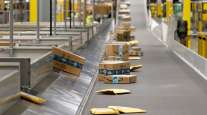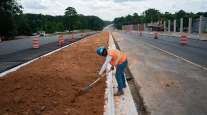Economy Grew Less-Than-Forecast 1.2% in Second Quarter

The U.S. economy expanded less than forecast in the second quarter after a weaker start to the year than previously estimated as companies slimmed down inventories and remained wary of investing amid shaky global demand.
Gross domestic product rose at a 1.2% annualized rate after a 0.8% advance the prior quarter, Commerce Department figures showed July 29 in Washington. The median forecast of economists surveyed by Bloomberg News called for a 2.5% second-quarter increase.
The report raises the risk to the outlook at a time Federal Reserve policymakers are looking for sustained improvement. Where consumers were resilient last quarter, businesses were cautious — cutting back on investment and aggressively reducing stockpiles amid weak global markets, heightened uncertainty and the lingering drag from a stronger dollar.
“We’re just muddling through," said Joseph LaVorgna, chief U.S. economist at Deutsche Bank Securities Inc. in New York, who had forecast a 1% gain in second-quarter GDP. “Consumer spending looks good, but the problem is that the rest of the economy is soft. The economy remains vulnerable to downside risks. The Fed is right to be cautious."
Private fixed investment, which includes residential and business spending, dropped at a 3.2% pace in the second quarter, the most in seven years.
With the July 29 report, the Commerce Department also issued its annual revisions, updating the data back through 2013. The first-quarter’s reading was revised from a previously reported 1.1% gain.
Economists’ second-quarter estimates for GDP, or the value of all goods and services produced, ranged from 1% to 3.2%. The growth estimate is the first of three for the quarter, with the other releases scheduled for August and September when more information becomes available.
Inventories were reduced by $8.1 billion in the second quarter, the most since third quarter of 2011 and subtracting 1.16 percentage points from the economy. At the same time, leaner inventories could set the stage for a pickup in production later this year should demand hold up.
Household consumption, which accounts for about 70% of the economy, grew at a 4.2% annualized rate, the biggest jump since the end of 2014 and adding 2.83 percentage points to growth. That followed a revised 1.6% increase from January through March. The Bloomberg survey median forecast for the second quarter was 4.4%.
Corporate spending on equipment, structures and intellectual property decreased an annualized 2.2% after a 3.4% fall in the first quarter. Outlays for equipment dropped for the fourth quarter in the last five. Spending on structures — everything from factories to shops to oil rigs — have increased in just one quarter since the end of 2014.
Inventories and the trade gap are two of the most volatile components in GDP calculations. To get a better sense of demand in the United States, economists look at final sales to domestic purchasers, or GDP excluding inventories and net exports. That measure increased 2.1% last quarter after a 1.2% gain.
Also holding back economic growth in the second quarter was a decrease in residential investment, which fell at a 6.1% pace. That was the most since the third quarter of 2010 and marked the first decrease in two years.
Government spending also shrank last quarter, declining 0.9%, the most in more than two years as outlays for the military fell. States and municipalities also cut back.
The GDP report also showed price pressures remain limited. A measure of inflation, which is tied to consumer spending and strips out food and energy costs, climbed at a 1.7% annualized pace compared with 2.1% in the prior quarter.
Fed policymakers, who left interest rates unchanged this week, said risks to the U.S. outlook have “diminished” and the labor market is getting tighter, suggesting conditions are turning more favorable for an increase in borrowing costs.




